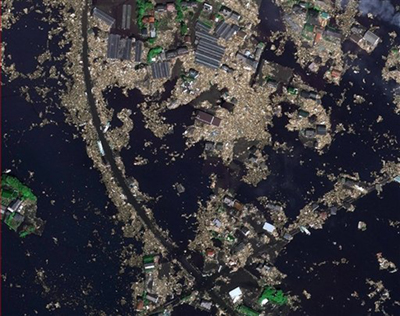
In this picture publicly provided by the German aerospace DLR and their crisis center on Monday March 14, 2011 the Japanese city of Sendai is pictured on Saturday March 12, 2011 after the earthquake and the following tsunami. (AP Photo/DLR ZKI)
Since the strike of an 8.9 magnitude earthquake east of Sendai, Japan at 2:46 PM local time last Friday, the rest of the world has been watching in horror as one catastrophe has unfolded upon another. A devastating tsunami striking Japan’s northeastern coast, then growing concerns about the possible release of radioactivity from six nuclear reactors whose cooling systems were disrupted by the quake, all adding up to the worst destruction the country has seen in 65 years. The vast extent of the damage has revealed itself as rescuers move into the affected areas. Estimates early in the week place the number of casualties above 10,000, with 500,000 said to have been displaced.
The crisis continues to play out, with the nuclear failure possibly the most serious front of all, but mercifully, humanitarian efforts are already under way in some areas. To supplement Japan’s own considerable response actions, the United States quickly deployed naval rescue vessels to the Japanese coast, including the USS Ronald Regan, carrying relief supplies and manpower in an effort that’s being called “Operation Tomodachi,” which is Japanese for “friendship.” The U.S. Agency for International Development (USAID) has sent search and rescue teams and disaster response units of its own.




 Facebook
Facebook Permalink
Permalink Digg
Digg Reddit
Reddit LinkedIn
LinkedIn StumbleUpon
StumbleUpon Tumblr
Tumblr

